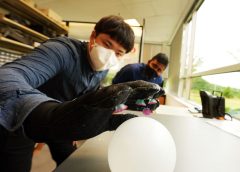
Underwater glove puts octopus’ abilities on the hand of humans | VTx
[ad_1]
“When we look at the octopus, the adhesive certainly stands out, quickly activating and releasing adhesion on demand,” said Bartlett. “What is just as interesting, though, is that the octopus controls over 2,000 suckers across eight arms by processing information from diverse chemical and mechanical sensors. The octopus is really bringing together adhesion tunability, sensing, and control to manipulate underwater objects.”
Putting the inspiration into action
To design their glove, the researchers focused on re-imagining the suckers: compliant, rubber stalks capped with soft, actuated membranes. The design was created to perform the same function as the sucker of an octopus — activating a reliable attachment to objects with light pressure, ideal for adhering to both flat and curved surfaces.
Having developed the adhesive mechanisms, they also needed a way for the glove to sense objects and trigger the adhesion. For this, they brought in Assistant Professor Eric Markvicka from the University of Nebraska-Lincoln, who added an array of micro-LIDAR optical proximity sensors that detect how close an object is. The suckers and LIDAR were then connected through a microcontroller to pair the object sensing with the sucker engagement, thus mimicking the nervous and muscular systems of an octopus.
Using the sensors to engage the suckers also makes the system adaptable. In a natural environment, an octopus winds its arms around crags in rocks and surfaces, attaching to smooth shells and rough barnacles. The research team also wanted something that felt natural to humans and allowed them to pick things up effortlessly, adapting to different shapes and sizes as an octopus would. Their solution was a glove with synthetic suckers and sensors tightly integrated together, a harmony of wearable systems grabbing many different shapes underwater. They called it Octa-glove.
“By merging soft, responsive adhesive materials with embedded electronics, we can grasp objects without having to squeeze,” said Bartlett. “It makes handling wet or underwater objects much easier and more natural. The electronics can activate and release adhesion quickly. Just move your hand toward an object, and the glove does the work to grasp. It can all be done without the user pressing a single button.”
Putting on the glove
In testing, the researchers tried a few different gripping modes. To manipulate delicate and lightweight objects, they used a single sensor. They found that they could quickly pick up and release flat objects, metal toys, cylinders, the double-curved portion of a spoon, and an ultrasoft hydrogel ball. By reconfiguring the sensor network to utilize all sensors for object detection, they also were able to grip larger objects such as a plate, a box, and a bowl. Flat, cylindrical, convex, and spherical objects consisting of both hard and soft materials were adhered and lifted, even when users did not grab the object by closing their hands.
“These capabilities mimic the advanced manipulation, sensing, and control of cephalopods and provide a platform for synthetic underwater adhesive skins that can reliably manipulate diverse underwater objects,” said postdoctoral researcher Ravi Tutika. “This is certainly a step in the right direction, but there is much for us to learn both about the octopus and how to make integrated adhesives before we reach nature’s full gripping capabilities.”
Looking forward, the researchers envision the glove playing a role in the field of soft robotics for underwater gripping, applications in user-assisted technologies and health care, and in manufacturing for assembling and manipulating wet objects.
This work was performed with Sean Frey, A.B.M. Tahidul Haque, Elizabeth Krotz, Cole Haverkamp, and Chanhong Lee, representing Virginia Tech, Iowa State University, and the University of Nebraska-Lincoln. The research was supported by the National Science Foundation through the Designing Materials to Revolutionize and Engineer our Future program.
[ad_2]
Source link


